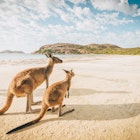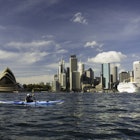

Hiking in Fortescue Bay, Tasmania © RooM the Agency / Alamy Stock Photo
s travel reputation is written in green. Around 20% of island state is protected as World Heritage-listed wilderness, the planet's cleanest air blows over Tasmania, and it was home to the world's first Green political party in 1972.
Like anywhere, however, there are threats and challenges to this green and clean environment, with national parks opened to private tourism operations in recent years, and a perpetual unease between industry and conservationists.
For environmentally minded travelers, it becomes imperative to seek experiences and operators that go above and beyond to adhere to sustainable practices, preserving this unique and wonderful place for future generations.

Raft the Franklin River
The wild Franklin River is a touchstone of Australian environmentalism. In the early 1980s, it was the scene of highly public and successful protests against hydroelectric dams. Today the river runs free, flowing through a catchment that contains not a single building or patch of cultivated land. Rafting trips on the 100-km-long wilderness river take around seven days, and whichever company you raft with – Tasmanian Expeditions, or Water by Nature – regulations require all waste to be taken out at the end of the trip, including human waste. You'll never forget the "groover" – the metal box used to transport said leftovers.

Wildlife parks
The Tasmanian devil is the state's virtual icon, but they're rarely sighted in the wild as the population has been decimated over the last two decades by Devil Facial Tumour Disease. Wildlife parks across Tasmania provide an easy glimpse of the curious animal and other native critters, with a couple of parks at the forefront of the fight to protect and preserve Tasmania's wildlife.
On the outskirts of , the Bonorong Wildlife Sanctuary operates the state's largest wildlife rescue service. An estimated 500,000 animals are killed on Tasmanian roads every year, and Bonorong collects and treats injured animals in its on-site wildlife hospital. Visitors can wander through the hospital, observing vets at work.
On the Tasman Peninsula, the unfenced Tasmanian Devil Unzoo works closely with the Tasmanian Devil Conservation Project, monitoring and collecting data on wild devils, and maintaining a devil-proof fence to protect the state's last natural and isolated disease-free population.

Change Overnight
Opened last year, is a Launceston hotel with a social-cause agenda. Guests get to choose from eight causes, with a portion of your payment donated to that particular organization. Your money might buy 10 sq meters of land for a Tasmanian environmental conservancy, or provide breakfast to 210 children in an Indian orphanage. In addition, you also get a fine stay at the edge of Launceston's city centre, with 18 light-filled rooms inside an old industrial building, just steps from one of the city's finest cafe strips.
Tasmanian ecolodges
Elsewhere, there are some excellent options for accommodation with a sustainable edge. On Hobart's fringe, has two small pods – the Vanilla Pod and the Pea Pod – that feature solar passive design, self-sufficient water supply and reed beds for on-site grey-water absorption.
Outside of Launceston, looks like a stylish implant from the hills of Los Angeles, and is entirely emission free. An off-grid solar-charged battery fulfils the home's power needs entirely.
Little more than an hour's drive northeast of Launceston, the Tin Dragon Cottages sit at the edge of the Derby mountain-biking trail network and feature five cottages constructed with timber sourced entirely from the rural property. Power is generated by a micro-hydro system, while water is supplied from rain catchment, and all grey water is recycled onto the paddocks below the cottages.

wukalina walk
For too long, a myth persisted that Tasmania's Aboriginal lineage ended with the death of local woman Truganini in 1876, but palawa (Tasmanian Aboriginal) culture and community live on. The wukalina walk is the first tourism venture from Tasmania's palawa community, leading guests on a four-day walk along the stunning Bay of Fires coastline in the state's northeast.
It's a stretch of coast as brilliantly colored as any in the world, but culture also runs large through the trip. You'll enjoy dinners of muttonbird harvested by time-honored methods used by generations of palawa, foraging for bush tucker as you hike. The first two nights are spent in architecturally designed pods shaped to recall ancient palawa shelters, and the final night in lighthouse keeper cottages at Eddystone Point.

Cycling adventures
In 2015, a network of mountain bike trails was constructed around the forlorn former tin-mining town of Derby, in Tasmania's northeast, to immediate impact. The trails are considered among the finest in the world, providing a sustainable activity in a world-class setting. runs guided three- and four-day trips at Derby, with nights spent in eco-friendly pods ingeniously hidden within the trail network.
The pods and the attached central hub are fully solar-powered. All water is harvested from rainfall and solar-heated. When the pods were constructed in 2017, builders preserved vegetation by strapping trees back rather than cutting them down. Elsewhere, Tasmanian eBike Adventures runs small-scale environmental and cultural bike rides on Maria Island and on one of Tasmania's most storied rural properties near Port Arthur. The trip incorporates a traditional healing ceremony with a palawa guide and healer.

Maria Island
Tasmania's island national park is a wondrous place – effectively two islands tied together by a paper-thin isthmus, with 700-meter-high mountains rearing out of the sea, copious wildlife and a World Heritage-listed convict station. Wombats, wallabies and even an insurance population of Tasmanian devils blithely wander the grasslands of the vehicle-free island. Visitors can take the , promising to "explore with a sense of responsibility, adventure and kindness."
The island is also the focus of the four-day , which was named Australia's best ecotourism operator at the 2019 Australian Tourism Awards. The walk covers the length of the island, staying in semi-permanent camps raised off the ground to protect the landscape (the camps are dismantled at the end of each season). Guests clear rubbish from the beaches and coast as they walk. The company also plays a role in monitoring Tasmanian devil scat and revegetating parts of the island.
You may also like:
The 10 best island destinations in Australia
How to have a sustainable visit to the Great Barrier Reef
Escape into nature and isolate yourself in a luxurious pod
Explore related stories





 Wildlife & NatureThese 10 sustainable travel experiences are both exciting and rewarding
Wildlife & NatureThese 10 sustainable travel experiences are both exciting and rewardingAug 8, 2024 • 6 min read
 ActivitiesA first-time guide to Launceston and the Tamar Valley, Australia
ActivitiesA first-time guide to Launceston and the Tamar Valley, AustraliaAug 7, 2024 • 8 min read
 OutdoorsKayak, SUP and whitewater: the best places to paddle in Australia
OutdoorsKayak, SUP and whitewater: the best places to paddle in AustraliaJun 19, 2024 • 7 min read


